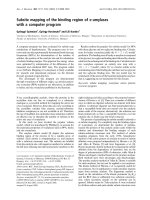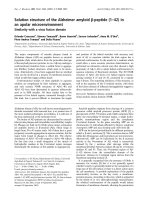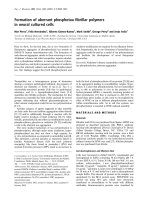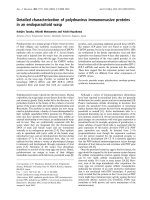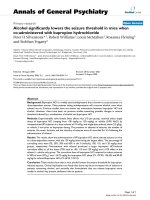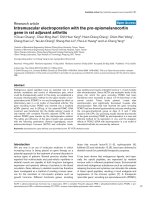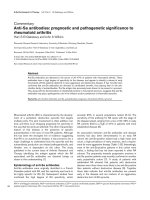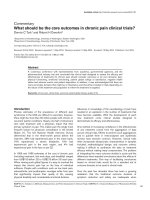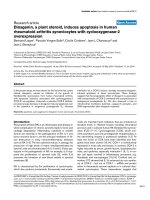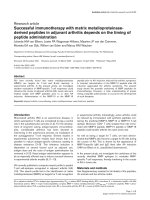Báo cáo y học: " Intramuscular electroporation with the pro-opiomelanocortin gene in rat adjuvant arthritis" doc
Bạn đang xem bản rút gọn của tài liệu. Xem và tải ngay bản đầy đủ của tài liệu tại đây (887.61 KB, 8 trang )
Introduction
We are now in an era of molecular medicine in which
increasing focus is being placed on gene therapy as a
potential approach for the treatment of several disorders in
various types of patients. Several previous studies have
reported that multinucleate and post-mitotic myofibres in
skeletal muscle are capable of both long-term transgene
expression and systemic delivery of proteins to the blood
circulation. Gene delivery to skeletal muscle has therefore
been investigated as a method of creating a tissue reser-
voir for the secretion of non-muscle proteins such as
growth hormone. Different functional genes, including
those that encode factor IX [1–3], erythropoietin [4],
kallikrein [5] and interleukin-12 [6], have been delivered to
skeletal muscle for potentially therapeutic purposes.
It has been shown that endogenous ligands, and espe-
cially the opioid peptides, are expressed by resident
immune cells in inflamed peripheral tissue. Environmental
stimuli and endogenous substances such as corticotropin-
releasing hormone and cytokines can stimulate the release
of these opioid peptides, resulting in local analgesia and
suppression of the immune system [7]. A therapeutic
‘pain-killer gene’, encoding pro-opiomelanocortin (POMC),
ACTH = adrenocorticotropic hormone; bp = base pairs; CFA = complete Freund’s adjuvant; PBS = phosphate-buffered saline; POMC = pro-
opiomelanocortin; RIA = radioimmunoassay; RT–PCR = reverse transcriptase polymerase chain reaction.
Available online />Research article
Intramuscular electroporation with the pro-opiomelanocortin
gene in rat adjuvant arthritis
I-Chuan Chuang
1
, Chien-Ming Jhao
2
, Chih-Hsun Yang
3
, Hsien-Chang Chang
1
, Chien-Wen Wang
1
,
Cheng-Yuan Lu
3
, Yao-Jen Chang
3
, Sheng-Han Lin
3
, Pao-Lin Huang
4
and Lin-Cheng Yang
4
1
Institute of Biomedical Engineering, National Cheng Kung University, Tainan, Taiwan
2
Institute of Biomedical Engineering, National Taiwan University Hospital, Taipei, Taiwan
3
Gene Therapy Laboratory, Chang Gung Memorial Hospital, Kaohsiung, 833, Taiwan
4
Gene Therapy Laboratory, Tajen Institute of Technology, Pingtung, 907, Taiwan
Corresponding author: Lin-Cheng Yang (e-mail: )
Received: 14 Aug 2003 Revisions requested: 17 Sep 2003 Revisions received: 18 Sep 2003 Accepted: 30 Sep 2003 Published: 17 Oct 2003
Arthritis Res Ther 2004, 6:R7-R14 (DOI 10.1186/ar1014)
© 2004 Chuang et al., licensee BioMed Central Ltd (Print ISSN 1478-6354; Online ISSN 1478-6362). This is an Open Access article: verbatim
copying and redistribution of this article are permitted in all media for any purpose, provided this notice is preserved along with the article's original
URL.
Abstract
Endogenous opioid peptides have an essential role in the
intrinsic modulation and control of inflammatory pain, which
could be therapeutically useful. In this study, we established a
muscular electroporation method for the gene transfer of pro-
opiomelanocortin (POMC) in vivo and investigated its effect on
inflammatory pain in a rat model of rheumatoid arthritis. The
gene encoding human POMC was inserted into a modified
pCMV plasmid, and 0–200 µg of the plasmid-POMC DNA
construct was transferred into the tibialis anterior muscle of
rats treated with complete Freund’s adjuvant (CFA) with or
without POMC gene transfer by the electroporation method.
The safety and efficiency of the gene transfer was assessed
with the following parameters: thermal hyperalgesia, serum
adrenocorticotropic hormone (ACTH) and endorphin levels,
paw swelling and muscle endorphin levels at 1, 2 and 3 weeks
after electroporation. Serum ACTH and endorphin levels of the
group into which the gene encoding POMC had been
transferred were increased to about 13–14-fold those of the
normal control. These levels peaked 1 week after
electroporation and significantly decreased 2 weeks after
electroporation. Rats that had received the gene encoding
POMC had less thermal hypersensitivity and paw swelling than
the non-gene-transferred group at days 3, 5 and 7 after
injection with CFA. Our promising results showed that transfer
of the gene encoding POMC by electroporation is a new and
effective method for its expression in vivo, and the analgesic
effects of POMC cDNA with electroporation in a rat model of
rheumatoid arthritis are reversed by naloxone.
Keywords: electroporation, gene delivery, pro-opiomelanocortin, RT–PCR, skeletal muscle
Open Access
R7
R8
Arthritis Research & Therapy Vol 6 No 1 Chuang et al.
produces the opioid peptides β-endorphins, other shorter
endorphins, adrenocorticotropic hormone (ACTH) and
α-melanocyte stimulating hormone. Injection of POMC
cDNA with a gene gun has produced analgesic effects in
phase 2 of the formalin test [8]. The possibility exists that
this exogenous POMC-mediated analgesia could be used
for the control of chronic inflammatory pain such as
rheumatoid arthritis or osteoarthritis.
Various studies have focused on the application of gene
delivery using viral vectors such as adenovirus, retrovirus
and herpes simplex virus for muscle-based gene therapy.
However, the use of these viruses as vectors has been hin-
dered by viral cytotoxicity, host immune rejection after
repeat dosing, and limited transient transgene expression
[9–12]. Adenoviral vectors are able to infect both mitotic
myoblasts and post-mitotic immature myofibres and can be
prepared at high titres (10
9
to 10
11
plaque-forming units/ml)
[13,14]. However, stability and long-term transgene expres-
sion using first-generation adenoviral vectors have been
hampered by the immune rejection in muscle. In addition,
novel mutant vectors were developed subsequently and
such mutants have reduced the problems associated with
viral cytotoxicity and immune rejection [2,15,16].
Electroporation is a physical method of introducing macro-
molecules into cells by applying a brief electrical pulse
that causes transient changes in membrane permeability
[17–19]. Moreover, electroporation as applied to muscle
has been found to be relatively safe, and has the additional
advantage of not being restricted by post-mitotic muscle
cells. On the basis of the principle of electroporation, we
developed a new strategy to achieve the transfer of the
gene encoding the intramuscular ‘pain-killer’ POMC in
vivo and determined the optimal transfection efficiency.
The safety of the procedure, in terms of potential damage
to muscle tissue, and the effectiveness of the gene trans-
fer (that is, analgesic potency) were assessed by using
parameters including thermal hyperalgesia, serum ACTH,
endorphin, paw swelling and muscle endorphin levels after
intramuscular electroporation into rats in which arthritis
was induced by the injection of complete Freund’s adju-
vant (CFA).
Materials and methods
Construction of plasmid human POMC DNA
(pCMV–POMC)
Total RNA from human pituitary gland was extracted by
TriZol Reagent (Clontech Co). The cDNA was synthesized
by reverse transcription with oligo(dT) as primer
(BcaBEST RNA PCR kit; TaKaRa Biomedicals Co). The
gene encoding POMC was then amplified by polymerase
chain reaction (PCR) with specific upstream and down-
stream oligonucleotides. The upstream oligonucleotide
was 5′-CAG ggT aCC TGG AAG ATG CCG AGA TC-3′,
and the downstream oligonucleotide was 5′-CCT GGG
taC
CGC TGT GCC CTC ACT CG-3′, where lower case
letters indicate changes to meet the KpnI cutting site
(underlined). The PCR product contains the full-length
coding region of the gene encoding POMC with the
expected length of 854 base pairs (bp). After cloning into
pUC18 vector, white colonies (lacZ mutation) were
selected, and plasmid DNA was purified with a Mini
Plasmid DNA preparation Kit (Qiagen), digested with KpnI
and subjected to electrophoresis on an agarose gel. The
plasmids with the correct insert were verified by DNA
sequencing. The correct POMC gene was then cloned to
the KpnI site of pCMV-Script (Clontech Co.). The prepara-
tion and purification of the plasmid from cultures of
pCMV–POMC-transformed Escherichia coli were per-
formed by the column method (Qiagen Mega Kit; Qiagen
Inc, Valencia, CA, USA). The purified plasmid was diluted
in phosphate-buffered saline (PBS) to appropriate con-
centrations according to the injection dose: 200 µg
(1.0 µg/µl) and 20 µg (0.1 µg/µl).
Animals
All experimental procedures were reviewed and approved
by the Institutional Animal Care and Use Committee
before the study was initiated. These adhered to the
guidelines for pain experiments in awake animals. Male
Sprague–Dawley rats (350–375 g, Sprague–Dawley,
National Science Council, Taipei, Taiwan) were used in
this study. Two groups of rats were used, normal
(nonarthritic control) and CFA-treated (arthritis group)
rats. Each group was further divided into subgroups, with
seven test animals or seven control animals in each sub-
group. They were group-housed, and the temperature was
maintained at 22°C on a 12 hours light/12 hours dark
cycle. Nonarthritic control animals were also group-
housed separately from the arthritis groups. The experi-
menter was blinded to treatment classification throughout
the study, although inflammation related to the adjuvant
was evident during behavioural testing.
Injection and electroporation of intramuscular
pCMV–POMC
Aliquots (200 µl) of POMC-plasmid DNA were adminis-
tered into the medial or lateral sides of the right lower leg
by direct intramuscular injection with 30-gauge needle.
Immediately after intramuscular injection of POMC-
plasmid DNA, electroporation followed, with two heads of
a caliper electrode positioned at the two sides of the right
lower leg of the test animals. The pulse was applied to the
two electrodes with a pulse generator (BTX ECM830;
Genetronics, San Diego, CA, USA). The parameters were
10 pulses (25 ms per pulse, separated by 2 minutes, with
a current of 100 V/cm.)
Injection of CFA
Arthritis was induced by injecting 0.3 ml of 5.0 mg/ml CFA
(consisting of heat-killed Mycobacterium butyricum in
R9
mineral oil) intradermally into the plantar surface of the left
hindpaw at day 7 after intramuscular injection and electro-
poration. Adjuvant was injected into rats under anaesthesia
in a Plexiglas box with 3% isoflurane in a 1:1 mixture of O
2
and room air.
Determinations of ACTH and endorphin
Blood sampling
Before blood collection, rats were deeply anaesthetized
with isoflurane. About 2 ml of blood was sampled from the
heart at 1, 2 and 3 weeks after transfection with the gene
encoding POMC. Seven rats per time point were used to
analyse the ACTH and endorphin levels in serum. Serum
from rats that received direct intramuscular injection of
DNA without an electrical pulse or from rats transfected
with PBS only (no DNA) served as the control group.
Endorphin and ACTH concentrations were assayed with a
radioimmunoassay (RIA) kit (Nichols Institute Diagnostics,
San Juan Capistrano, CA, USA). This kit has a linear range
of measurement between 5 and 200 pg/ml ACTH and
endorphin, with a detection threshold of 5 pg/ml.
Muscle protein extraction
Rats were rapidly decapitated under deep general anaes-
thesia. Transfected and nontransfected muscles were
retrieved at days 3, 5, 7 and 14 after injection with CFA.
Seven rats per time point were used to analyse the ACTH
and endorphin levels in muscle. The rats that received the
direct intramuscular injection of DNA without an electrical
pulse or those that were transfected with PBS (no DNA)
served as the control group. Endorphin and ACTH con-
centrations were assayed by using human ACTH and
endorphin-specific RIA kits (Nichols Institute Diagnostics),
and the total cell protein was analysed with the Bio-Rad
protein assay. RIA values were normalized to total protein.
The muscle was removed and rapidly frozen in liquid nitro-
gen, then stored at –80°C before assay. The muscle was
homogenized by sonication in ice-cold lysis buffer (50 mM
Tris-HCl, pH 7.5, 150 mM NaCl, 2% Triton X-100,
100 µg/ml phenylmethylsulphonyl fluoride, 1 µg/ml apro-
tinin), then centrifuged at 50,000 g for 30 minutes at 4°C.
The protein content of the supernatant was determined
with the Bio-Rad protein assay system. An equal volume of
sample buffer (2% SDS, 10% glycerol, 0.1% bromophe-
nol blue, 2% 2-mercaptoethanol, 50 mM Tris-HCl, pH 7.2)
was added to the test and control samples.
Isolation of RNA and reverse transcriptase PCR
(RT–PCR) studies
RNA was extracted from muscle tissue by a standard
TRIzol
®
(Gibco) method, with some modifications [20].
Each muscle was homogenized in TRIzol reagent and
RNA was precipitated with propan-2-ol. Subsequently,
RNA was mixed in a solution consisting of 1 × PCR buffer,
0.01 unit/µl ribonuclease inhibitor and 0.04 unit/µl deoxyri-
bonuclease I. The reaction mixture was incubated at 37°C
for 30 minutes. Immediately after incubation, 0.25 µg/µl
proteinase K was added to the reaction mixture and incu-
bated again for 30 minutes. After precipitation of RNA,
cDNA synthesis was performed with oligo(dT) primer, as
described by the manufacturer. PCR was performed with
an amplification cycle profile consisting of 94°C for
1 minute, 62°C for 1 minute and 72°C for 2 minutes per
cycle. After 30 PCR cycles, an additional cycle at 72°C for
7 minutes was performed to ensure complete DNA exten-
sion. The endorphin primers were designed on the basis
of the pE-POMC mRNA sequence and were as follows:
sense, 5′-AG ACT GCA AGA TGG TC-3′; antisense, 5′-T
GTA CGA CAG CAG GTA-3′; a 454 bp product resulted.
Primers for the β-actin were designed on the basis of the
rat cytoplasmic β-actin gene (GenBank accession number
V01217) and were as follows: sense, 5′-ACA CCC CAG
CCA TGT ACG-3′; antisense. 5′-TGG TGG TGA AGC
TGT AGC C-3′; a 225 bp product resulted.
Assessment of thermal nociception
Before and after the induction of the adjuvant arthritis, the
thermal nociceptive threshold of the rats was measured by
using a modification of the plantar test. The animal was
placed on a glass plate (maintained at 30°C) for
5–10 minutes for adaptation. The latency between the
application of a focused light beam and the hindpaw with-
drawal response was measured to the nearest
0.1 second. The cut-off time in the absence of a response
was 20 seconds. This value was then assigned as the
response latency.
Water displacement for assessment of joint swelling
The severity of inflammation was monitored daily on days
0–14 by measuring hindpaw volume by water displace-
ment. Swelling (water displacement [ml], means ± SEM) is
shown in Fig. 4 (n = 7 per group).
Morphology and immunohistochemistry
Muscle tissues for the histological study were fixed with
4% paraformaldehyde in PBS for 4 hours and then in 30%
sucrose in PBS overnight. The muscle tissues were
cryosectioned to a thickness of 10 µm, and blocked in 2%
normal goat serum for 2 hours at room temperature. Sec-
tions were then incubated for 2 days with primary rabbit
anti-endorphin antibody (1:500; Chemicon, Temecula,
CA, USA) in 10% normal goat serum and 0.3% Triton
X-100 (Sigma, St Louis, MO, USA) at 4°C. To ensure that
immunostaining was specific, control samples were incu-
bated in the same solutions without primary antibody. The
sections were washed three times with 0.2% Triton X-100
in PBS, then incubated with fluorescence-conjugated sec-
ondary antibodies (Jackson ImmunoResearch, West
Grove, PA, USA) for 1 hour. The slides were then sealed
with the Prolong Antifade kit (Molecular Probes, Eugene,
OR, USA) after drying, and subjected to image analysis.
To record the images, slides were examined with a fluores-
Available online />cence confocal microscope (Leica, TCS, SPII, Heidelberg,
Germany). Microscopic examination of the electroporated
muscle was performed on a paraffin section of formalin-
fixed muscle. Ten transverse sections from one extremity
to the other were performed and stained with haematoxylin
and eosin. All sections were assessed by a blinded
observer.
Statistical analysis
The paw withdrawal latency data and the RIA data for
β-endorphin and ACTH levels were expressed as
means ± SEM. One-way analysis of variance for repeated
measures with Bonferroni post-hoc analysis was used to
detect differences between the groups. P < 0.05 was con-
sidered significant.
Results
Two groups of rats were used in the study: normal rats
and rats treated with CFA to induce arthritis.
Time course of serum ACTH and endorphin levels in
normal rats
Rats in group A (normal rats) were assigned to five sub-
groups (SG), I, II, III, IV and V, as follows: SG I (n = 7),
intramuscular electroporation with 200 µg of pCMV–
POMC; SG II (n = 7), intramuscular electroporation with
20 µg of pCMV–POMC; SG III (n = 7), intramuscular
electroporation with PBS; SG IV (n = 7), intramuscular
injection with 200 µg of pCMV–POMC without electro-
poration; and SG V (n = 7), injection of PBS without
electroporation, as control group.
The serum levels of ACTH and endorphin in SG III and
SG IV were not significantly increased in comparison with
the SG V control group. SG II rats, which received 20 µg
of pCMV–POMC by electroporation, showed a modest
increase in the levels of ACTH and endorphin, but this
was not statistically significant when compared with SG V.
In contrast, SG I, which received intramuscular electropo-
ration with 200 µg of pCMV–POMC, showed increases in
the serum level of ACTH and endorphin that peaked at
2586 and 1859 pg/ml at week 1, respectively. This gradu-
ally decreased to 750 and 351 pg/ml at week 3, respec-
tively. At all time points of the reported experiment, the
serum level of endorphin in SG I was much higher than
that of SG IV (from 12-fold at 7 days to 3.5-fold at
21 days). The time courses of serum ACTH and endorphin
after intramuscular electroporation with the gene encoding
POMC are shown in Figs 1 and 2.
Time course of serum ACTH and endorphin levels in
CFA-treated rats
We performed CFA injection at 1 week after muscle-tar-
geted transfer of 200 µg of pCMV–POMC or PBS using
intramuscular electroporation. CFA-treated rats were
divided into five subgroups (SG), VI, VII, VIII, IX and X, as
follows: SG VI (n = 7), intramuscular electroporation with
200 µg of pCMV–POMC followed by injection with CFA;
SG VII (n = 7), intramuscular electroporation with PBS fol-
lowed by injection with CFA; SG VIII (n = 7), intramuscular
PBS injection with CFA only (this group was used to
determine whether CFA itself significantly induced the
production of endogenous ACTH and endorphin); SG IX
(n = 7), treated as SG VI except that, 30 minutes before
the nociceptive test at 7 days after CFA injection, nalox-
one (1 mg/kg) was administered intraperitoneally to deter-
mine whether any analgesic effect was mediated through
the opioid receptors; and SG X (n = 7), intramuscular elec-
troporation with 200 µg of pCMV-Script vector alone
added to the negative control to demonstrate that pCMV-
Script vector alone could not induce POMC expression.
The serum levels of ACTH and endorphin in SG VII were
not significantly increased in comparison with the SG V
Arthritis Research & Therapy Vol 6 No 1 Chuang et al.
R10
Figure 1
Time course of POMC gene injection and electroporation on the blood
levels of ACTH. Results are means ± SEM. Statistical comparisons
between groups were made by analysis of variance; individual
comparisons were made with the post-hoc test. *P < 0.05.
Figure 2
Time course of POMC gene injection and electroporation on the blood
levels of beta-endorphin. Results are means ± SEM. Statistical
comparisons between groups were made by analysis of variance;
individual comparisons were made with the post-hoc test. *P < 0.05.
control. Moreover, there was no difference between
SG VII and the other control group (SG VIII, PBS and CFA
only). We can therefore answer that electroporation itself
did not induce significant expression of ACTH or systemic
effects. The serum levels of ACTH and endorphin in
SG VII were not significantly increased in comparison with
the SG V control. In contrast, SG VI, which received intra-
muscular electroporation with 200 µg of pCMV–POMC,
showed increases in the serum level of ACTH and endor-
phin that peaked at 2904 and 1642 pg/ml, respectively, at
week 1. This gradually decreased to 870 and 716 pg/ml,
respectively, at week 3. The time courses of serum of
ACTH and endorphin concentrations after intramuscular
electroporation with the gene encoding POMC in CFA-
treated rats are shown in Figs 1 and 2.
Effect of intramuscular electroporation with
pCMV–POMC on thermal threshold in control rats
The thermal nociceptive thresholds of control rats
(SG I–IV) including injection with 200 µg of
pCMV–POMC and electroporation did not show any dif-
ference from the PBS (SG V) injection group (P > 0.05)
(data not shown).
Effect of intramuscular electroporation with
pCMV–POMC on thermal hyperalgesia in CFA rats
The thermal hyperalgesia of CFA rats (SG VI) injected with
200 µg of pCMV–POMC and electroporation was signifi-
cantly improved at 3, 5 and 7 days after CFA injection in
comparison with the groups receiving PBS with electropo-
ration (SG VII) or only CFA injection (SG VIII) (P < 0.05;
Fig. 3). It is noteworthy that pCMV–POMC plus naloxone
(SG IX) showed similar thermal thresholds to SG VII,
SG VIII and SG X (pCMV vector alone) (P > 0.05; Fig. 3).
Inhibition of paw swelling in CFA rats
To determine the anti-inflammatory effects caused by intra-
muscular electroporation gene therapy with POMC, we
measured paw swelling in CFA rats in subgroups SG VII,
which received intramuscular electroporation with PBS,
and SG VI, which received 200 µg of pCMV–POMC.
SG VIII rats, which received only CFA injection, were used
as a control group. The peak effect was noted at day 7 in
SG VI (Fig. 4). Rats injected with PBS with electroporation
showed a similar degree of swelling to that of the control
group (CFA only). However, naloxone administered at
7 days after CFA injection was without any significant
effect in paw swelling in polyarthritic rats that received
200 µg of pCMV–POMC (SG IX).
Delivery of the gene encoding POMC to skeletal muscle
A high level of transfer of the gene encoding POMC was
obtained after electroporation of muscle tissue. This was
determined by analysis of the muscle endorphin level by
RIA (Fig. 5). The peak effect (650 pg/ml) was noted at
day 5 in SG VI. This gradually decreased to 189 pg/ml at
day 14 after CFA injection.
Muscle endorphin mRNA
Muscle endorphin mRNA was detected by RT–PCR from
week 1 to week 3 (Fig. 6). RT–PCR products of the
expected size (450 bp) were obtained with RNA extracted
from six pieces of muscle tissue transfected with
pCMV–POMC. This was true in all the POMC-transfected
Available online />R11
Figure 3
Thermal hypersensitivity responses during CFA injection. The POMC and
electroporation group (SG VI) suppressed the CFA-induced pain
(*P<0.05), showing a significant difference between rats receiving
electroporation and CFA (SG VII), CFA only (SG VIII) and electroporation
of pCMV vector alone (SG X), whereas naloxone reversed the analgesic
effects of POMC (SG IX). Results are means ±SEM.
Figure 4
Paw swelling during CFA injection in control rats (SG VIII) and rats
receiving POMC gene and electroporation (SG VI) and electroporation
and paw CFA injection (SG VII). POMC gene injection and
electroporation (SG VI) suppressed the swelling. Results are
means ± SEM. Statistical comparisons between groups were made by
analysis of variance; individual comparisons were made with the post-
hoc test. *P < 0.05.
animals. Control tissues failed to show any pCMV–POMC
mRNA by RT–PCR. These findings indicate that
pCMV–POMC mRNA was transcribed in the transfected
muscle (Fig. 6).
Immunohistochemistry
Intramuscular injection of 200 µg of pCMV–POMC fol-
lowed by electroporation was performed to see the effects
of transfection in muscle tissue and the location of endor-
phin. Peak fluorescence was noted at week 1 in the elec-
troporated muscle (Fig. 7). Muscle injected with DNA
without electroporation showed weaker immunoreactivity
than that in the control group (PBS injection without elec-
troporation).
Changes in muscle morphology after intramuscular
electroporation
We cannot exclude the possibility of low and transient
tissue damage induced by electroporation. However,
haematoxylin/eosin staining did not demonstrate abnormal
inflammatory cell infiltration or necrosis at the voltage
used.
Discussion
The results of this study show that intramuscular electro-
poration could serve as an alternative efficient method for
somatic gene delivery, in this case the gene encoding
POMC. This intramuscular electroporation method could
overcome many of the problems associated with viral gene
delivery to skeletal muscle, which is largely based on retro-
virus, adenovirus or herpes simplex virus. By avoiding the
use of these viral vectors, several such barriers or limita-
tions to gene delivery could be overcome. First among
such barriers is the cytotoxicity of these viral vectors,
which has hampered both viral transduction efficiencies
and long-term transgene expression after viral injection
[21,22]. Another barrier is the marked inflammatory
responses associated with the use of viral vectors and the
therapeutic protein, which lead to a significant decline in
the number of transduced myofibres [23,24]. Electropora-
tion has been shown to be a powerful gene delivery
method for muscle by creating pores in the membrane
through which plasmids can insert into the cells [25].
Efficiency and toxicity are the two most important aspects
in the search for potential pain gene therapies, with toxicity
often being the limiting factor. Because the gene encod-
ing POMC has not previously been transferred via the
intramuscular route and by electroporation, this study was
also designed to assess the safety of this intramuscular
gene therapy with pCMV–POMC. In addition, the relative
effectiveness of gene transfer was determined at two
plasmid concentrations. The results of our study showed
evidence of bioactivity in the form of ACTH and endorphin
gene expression at the protein level and in terms of anti-
hyperalgesic effects. From the perspective of safety
and/or acceptability, no significant adverse effects were
observed in this study in terms of respiratory depression
or sensory/motor dysfunction. Histological examination of
the electrotransfected muscle revealed no evidence of
damage after transfection, and there was no apparent
morbidity and definitely no mortality. We have shown that
intramuscular gene therapy with pCMV–POMC is safe.
Arthritis Research & Therapy Vol 6 No 1 Chuang et al.
R12
Figure 5
Effect of POMC injection on levels of endorphin in muscle at days 3, 5,
7 and 14 after injection with CFA. Results are means ± SEM.
Statistical comparisons between groups were made by analysis of
variance; individual comparisons were made with the post-hoc test.
*P < 0.05, showing a significant difference between rats receiving
electroporation (SG VII) and CFA only (SG VIII).
Figure 6
RNA levels of β-endorphin were measured at weeks 1, 2 and 3 after
injection with PBS (SG III) or 200 µg of POMC cDNA (SG I) and
electroporation. Results are means ± SEM. Statistical comparisons
between groups were made by two-tailed unpaired t-test. *P < 0.05,
showing a significant difference between the control groups and the
POMC gene and electroporation group.
However, these promising results should be further vali-
dated with multiple dosing and prolonged follow-up.
It would be very useful to determine whether the effect
might be mediated by ACTH or endorphin alone: a control
group consisting of animals given ACTH or endorphin
directly should be compared with the POMC gene trans-
fer group. In fact, it has been shown clinically in humans
that exogenous ACTH has antinociceptive effects when
administered by a single intramuscular injection of 40 IU of
ACTH. However, the effect of direct injection of ACTH
into the muscle is brief, so we do not expect any therapeu-
tic effect 7 days later [26].
The analysis of gene expression at the protein level by the
use of an RIA assay for ACTH and endorphin documented
considerable individual variability. Although the serial
ACTH levels in the POMC-transfected rats tended to peak
1–2 weeks after gene transfer, the degree of elevation
was highly variable. This might have been due to variable
transducibility with electroporation. However, the anti-
hyperalgesic and anti-inflammatory effects of gene delivery
corresponded to increased ACTH and endorphin levels
and were consistent with the time course of gene expres-
sion (3–21 days) that was established in animal studies.
This finding was a predictor of clinical improvement.
β-Endorphin has been shown to exert several effects on
the immune system, including the suppression of periph-
eral lymphocyte proliferation and the inhibition of natural
killer cell activity, interleukin-2 production and interferon-γ
production [26]. Moreover, a study on experimental
autoimmune encephalomyelitis in Lewis rats, the animal
model for multiple sclerosis, reported that administration
of the opioid antagonist naloxone markedly increases the
severity of the condition [27]. In our study, we found that
rats that received only CFA injection had low endorphin
levels compared with those receiving POMC with electro-
poration. At present we have no data to support the
hypothesis that the decrease in endorphin concentration
precedes the onset of inflammation, acting as a putative
cofactor for disease development.
The serum concentrations of ACTH and endorphin reflect
the transfection effects of POMC and its release, but not
its synthesis. However, high intramuscular concentrations
of endorphin corresponded to a sustained secretion of
β-endorphin from muscle. Moreover, a decrease in paw
swelling with POMC gene electroporation was observed,
as a consequence of the biological activity of ACTH and
endorphin. The increased synthesis of ACTH and endor-
phin might therefore also explain the balance between
proinflammatory and anti-inflammatory cascade. Our study
is the first to show an increase in endorphin and ACTH
concentrations during intramuscular electroporation gene
therapy.
In summary, these data indicate that intramuscular electro-
poration with the gene encoding POMC can mediate
potent antinociceptive effects. Opioid peptides unable to
cross the blood–brain barrier are the natural ligands for
opioid receptors. Peripheral gene therapy with the gene
encoding the ‘pain-killer’ POMC holds significant promise
for the control of inflammatory pain in conditions such as
rheumatoid arthritis and osteoarthritis.
Available online />R13
Figure 7
Confocal micrographs of POMC gene electroporation on endorphin
expression in muscle. (A) Immunohistochemical detection of endorphin
immunoreactivity in the negative control that omitted the primary
antibody. A muscle nucleus is labelled by 4,6-diamidino-2-phenylindole
(blue). (B) Overexpression of endorphin immunoreactivity (green) in
the POMC-treated group. Scale bar, 40 µm. (C) High-magnification
image (from (B)) of endorphin-positive puncta shows the detailed
distribution of endorphin in a muscle cell. Scale bar, 20 µm. (D)
Endorphin-positive puncta are absent from muscle electroporated with
pCMV-Script vector alone. Scale bar, 20 µm. (E, F) No significant
inflammatory cell infiltration or muscle damage on haematoxylin/eosin
staining of POMC-electroporated muscle (E) and untreated muscle (F).
Original magnification, ×200. Scale bar, 100 µm.
Competing interests
None declared.
Acknowledgements
We thank Professor Nina Gloriani Barzaga for her help in reading and
editing the manuscript. This work was performed with the support of
Chang Gung Memorial Hospital CMRP and the Taiwan National
Science Council NMRP (Genome Project).
References
1. Fewell JG, MacLaughlin F, Mehta V, Gondo M, Nicol F, Wilson E,
Smith LC: Gene therapy for the treatment of hemophilia b
using pinc-formulated plasmid delivered to muscle with elec-
troporation. Mol Ther 2001, 3:574-583.
2. Haecker SE, Stedman HH, Balice-Gordon RJ: In vivo expression
of full-length human dystrophin from adenoviral vectors
deleted of all viral genes. Hum Gene Ther 1996, 7:1907-1914.
3. Monahan PE, Samulski RJ, Tazelaar J, Xiao X, Nichols TC, Bellinger
DA, Read MS, Walsh CE: Direct intramuscular injection with
recombinant AAV vectors results in sustained expression in a
dog model of hemophilia. Gene Ther 1998, 5:40-49.
4. Rizzuto G, Cappelletti M, Mennuni C, Wiznerowicz M, DeMartis A,
Maione D, Ciliberto G, La Monica N, Fattori E: Gene electro-
transfer results in a high-level transduction of rat skeletal
muscle and corrects anemia of renal failure. Hum Gene Ther
2000, 11:1891-1900.
5. Emanueli C, Minasi A, Zacheo A, Chao J, Chao L, Salis MB,
Straino S, Tozzi MG, Smith R, Gaspa L, Bianchini G, Stillo F,
Capogrossi MC, Madeddu P: Local delivery of human tissue
kallikrein gene accelerates spontaneous angiogenesis in
mouse model of hindlimb ischemia. Circulation 2001, 103:
125-132.
6. Lucas ML, Heller R: Immunomodulation by electrically
enhanced delivery of plasmid DNA encoding IL-12 to murine
skeletal muscle. Mol. Ther 2001, 3:47-53.
7. Schafer M, Carter L, Stein C: Interleukin 1
ββ
and corticotropin-
releasing factor inhibit pain by releasing opioids from
immune cells in inflamed tissue. Proc Natl Acad Sci USA
1994, 91:4219-4223.
8. Lu CY, Chou AK, Wu CL, Yang CH, Chen JT, Wu PC, Lin SH,
Muhammad R, Yang LC: Gene-gun particle with pro-opiome-
lanocortin cDNA produces analgesia against formalin-induced
pain in rats. Gene Ther 2002, 9:1008-1014.
9. Feero WG, Rosenblatt JD, Huard J, Watkins SC, Epperly M,
Clemens PR, Kochanek S, Glorioso JC, Partridge TA, Hoffman
EP: Viral gene delivery to skeletal muscle: insights on matura-
tion-dependent loss of fiber infectivity for adenovirus and
herpes simplex type 1 viral vectors. Hum Gene Ther 1997, 8:
371-380.
10. Evans CH, Ghivizzani SC, Oligino TA, Robbins PD: Future of
adenoviruses in the gene therapy of arthritis. Arthritis Res
2001, 3:142-146.
11. Huard J, Krisky D, Oligino T, MarconiP, Day CS, Watkins SC, Glo-
rioso JC: Gene transfer to muscle using herpes simplex virus-
based vectors. Neuromuscul Disord 1997, 7:299-313.
12. Ozawa CR, Springer ML, Blau HM: A novel means of drug deliv-
ery: myoblast-mediated gene therapy and regulatable retrovi-
ral vectors. Annu Rev Pharmacol Toxicol 2000, 40:295-317.
13. Quantin B, Perricaudet LD, Tajbakhsh S, Mandel JL: Adenovirus
as an expression vector in muscle cells in vivo. Proc Natl Acad
Sci USA 1992, 89:2581-2584.
14. Vincent N, Ragot T, Gilgenkrantz H: Long-term correction of
mouse dystrophic degeneration by adenovirus-mediated
transfer of a mini-dystrophin gene. Nat Genet 1993, 5:130-
134.
15. Clemens PR, Kochanek S, Sunada Y: In vivo muscle gene trans-
fer of full-length dystrophin with an adenoviral vector that
lacks all viral genes. Gene Ther 1996, 3:965-972.
16. Kumar-Singh R, Chamberlain JS: Encapsidated adenovirus
minichromosomes allow delivery and expression of a 14 kb
dystrophin cDNA to muscle cells. Hum Mol Genet 1996, 5:913-
921.
17. Chang DC, Gao PQ, Maxwell BL: High efficiency gene transfec-
tion by electroporation using a radio-frequency electric field.
Biochim Biophys Acta 1991, 1092:153-160.
18. Liu F, Huang L: A syringe electrode device for simultaneous
injection of DNA and electrotransfer. Mol Ther 2002, 5:323-
328.
19. Lin CR, Yang LC, Lee TH, Lee CT, Huang HT, Sun WZ, Cheng
JT: Electroporation-mediated pain-killer gene therapy for
mononeuropathic rats. Gene Ther 2002, 9:1247-1253.
20. Chomczynski P, Sacchi N: Single-step method of RNA isolation
by acid guanidinium thiocyanate-phenol-chloroform extrac-
tion. Anal Biochem 1987, 162:156-159.
21. Johnson PA, Wong MJ, Friedman T: Improved cell survival by
the reduction of immediate-early gene expression in replica-
tion-defective mutants of herpes simplex virus type 1 but not
by mutation of the virion host shut-off function. J Virol 1994,
68:6347-6362.
22. Marconi P, Krisky D, Oligino T: Replication-defective herpes
simplex virus vectors for gene transfer in vivo. Proc Natl Acad
Sci USA 1996, 93:11319-11320.
23. Acsadi G, Lochmuller H, Jani A: Dystrophin expression in
muscles of mdx mice after adenovirus-mediated in vivo gene
transfer. Hum Gene Ther 1996, 7:129-140.
24. Gilchrist SC, Ontell MP, Kochanek S, Clemens PR: Immune
response to full-length dystrophin delivered to Dmd muscle
by a high-capacity adenoviral vector. Mol Ther 2002, 6:359-
368.
25. Axelrod D, Preston S: Comparison of parenteral adrenocorti-
cotropic hormone with oral indomethacin in the treatment of
acute gout. Arthritis Rheum 1988, 31:803-805.
26. Panerai AE, Manfredi B, Granucci F, Sacerdote P: The beta-
endorphin inhibition of mitogen-induced splenocytes prolifer-
ation is mediated by central and peripheral paracrine/
autocrine effects of opioid. J Neuroimmunol 1995, 58:71-76.
27. Panerai AE, Radulovic J, Monastra G, Manfredi B, Locatelli L, Sac-
erdote P: Beta-endorphin concentrations in brain areas and
peritoneal macrophages in rats susceptible and resistant to
experimental allergic encephalomyelitis: a possible relation-
ship between tumor necrosis factor alpha and opioids in the
disease. J Neuroimmunol 1994, 51:169-176.
Correspondence
Lin-Cheng Yang MD, Associate Professor, Gene Therapy Laboratory,
Tajen Institute of Technology, Pingtung, 907, Taiwan. Tel: +886 7
7317123; fax: +886 7 3791196; e-mail:
Arthritis Research & Therapy Vol 6 No 1 Chuang et al.
R14
